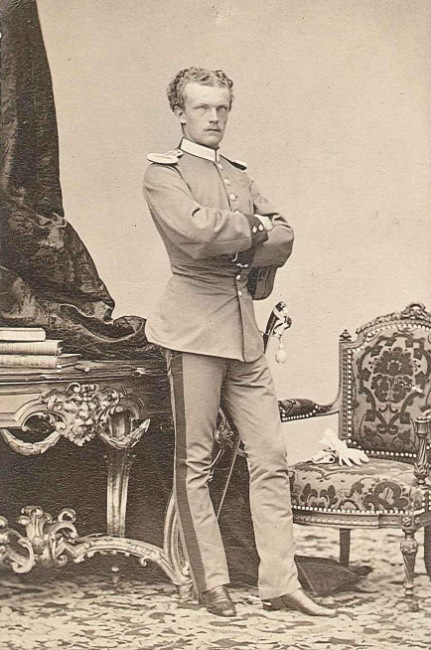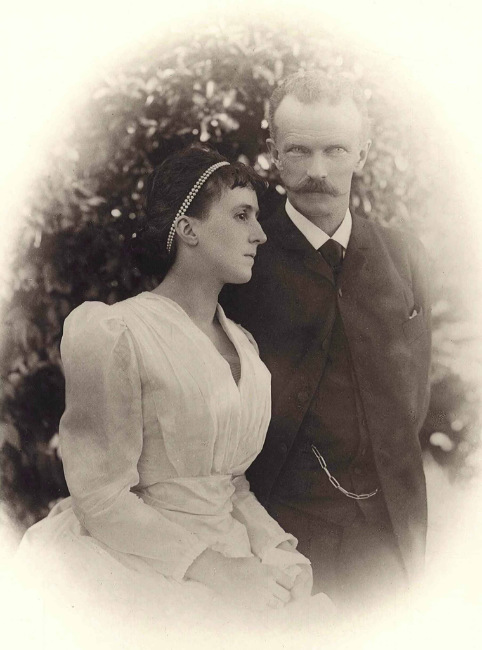Carl Theodor in Bavaria: The Old Nobility Takes Up a New Role
by Ursula Kampmann
In the context of Künker’s phaleristic sale at the end of October, the Osnabrück auction house will present orders from the estate of Carl Theodor Duke in Bavaria. Carl Theodor is one of the most interesting figures of Bavarian history. In contrast to his famous sister Sisi, he managed to live a fulfilled and self-determined life – as an eye specialist.
Content
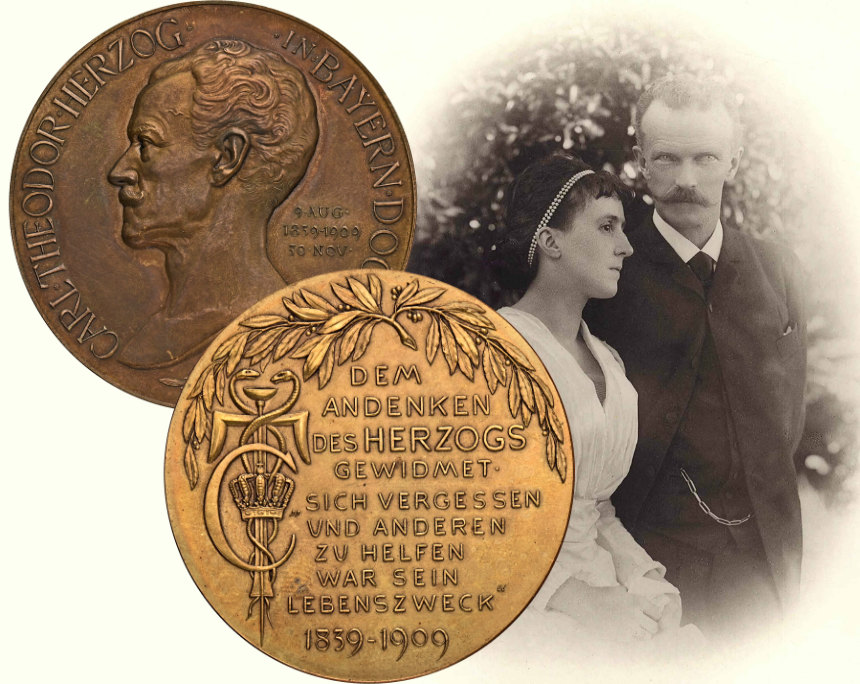
Wedding picture of Carl Theodor and his second wife Maria José from Portugal. Left: Medal commemorating the death of Carl Theodor on 30 November 1909. From Auction Künker 415 (28 October 2024), Lot 308. The reverse reads: “Dedicated to the memory of the Duke. Forgetting himself and helping others was his life’s purpose.”
The parents of Carl Theodor, born on 9 August 1839, had anything but a happy marriage. They had been forced to marry – not because there had been a child on its way, but because their wedding was to bring the two Wittelsbach branches closer together. While Ludovica was a relatively late born daughter of the reigning ruler Max I Joseph; Max in Bavaria, on the other hand, came from the younger Palatine branch, which had no right to claim the Bavarian throne as long as the older branch existed. Max was only 20 years old at the time of the wedding and strongly opposed an early marriage; and Ludovica was completely in love with Dom Miguel, the heir to the Portuguese throne. He loved her too, having already taken official steps to make her queen of Portugal. The families, however, were against it and ordered Max and Ludovica to marry – and so they did as they were told.
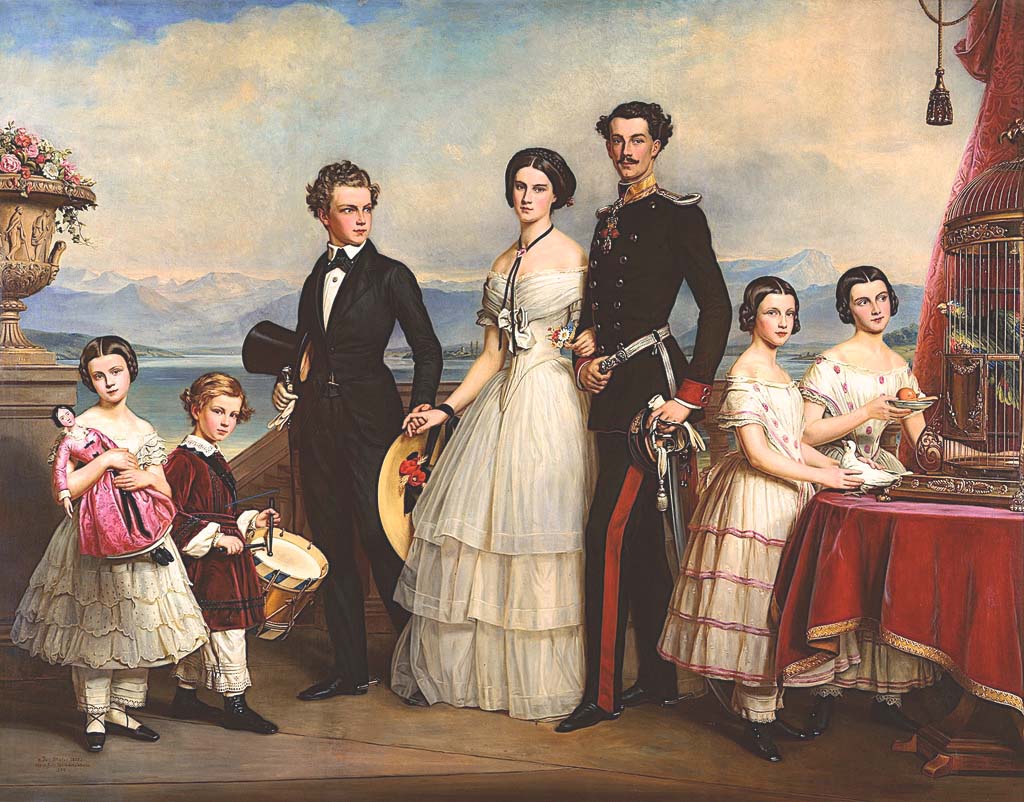
16-year-old Carl Theodor with his siblings against a mountain background. He is the third from the left. Painting by Karl Stieler dating back to 1855.
An Upbringing between Obligation and Self-Fulfillment
Every one to two years, Duke Max dutifully fathered a child. Ludovica lovingly raised her children at Possenhofen Castle and took care of their education. Yet she barely ever saw her husband. He preferred to go travelling, hunting or playing the zither in plain taverns instead. He built himself a resplendent palais in Munich with a circus ring, in which he himself performed as a trick rider. He had a second family in Bavaria’s capital and his three illegitimate children may have even seen him more often than his wife Ludovica.
Thus, within his own family, Carl Theodor came to experience the distinct ways of life that modern times were offering the old nobility. On the one hand, there was his mother who devoted herself completely to the ideals of duty and family; on the other hand, there was his father who did what he wanted no matter how much this may hurt other people.
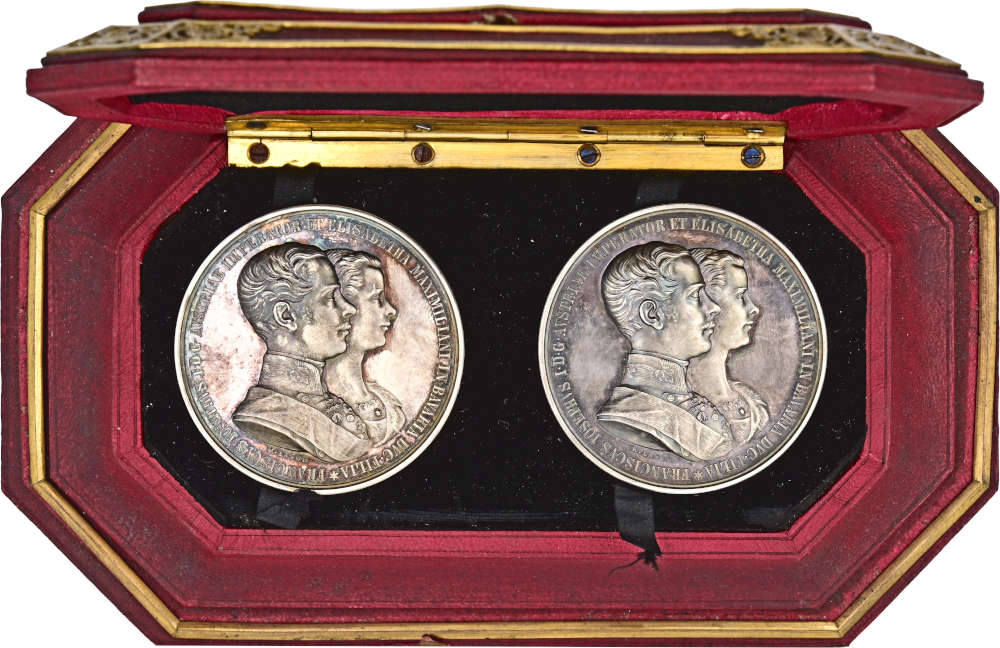
Lot 362: Official commemorative medal by Konrad Lange celebrating the wedding of Emperor Franz Joseph I and Elisabeth, Duchess in Bavaria on 24 April 1854 in Vienna. Pair of silver medals in original presentation case. Probably from the estate of Carl Theodor in Bavaria as a souvenir of the wedding. FDC. Estimate: 2,000 euros.
The children of Duke Max and Ludovica grew up at a time when the world was changing at a faster pace than ever before. Suddenly, there was more than one option when it came to how you had to live your life. For example, Ludwig Wilhelm, eldest son of Duke Max, renounced his birth right in order to marry the actress Henriette von Wallersee. His sister Sisi, on the other hand, reluctantly became empress and spent her life trying to circumvent her imperial duties whenever possible. Two medals in a presentation case commemorate her wedding. They are probably from Carl Theodor’s possessions, who received them as a souvenir like all the other noble wedding guests did.
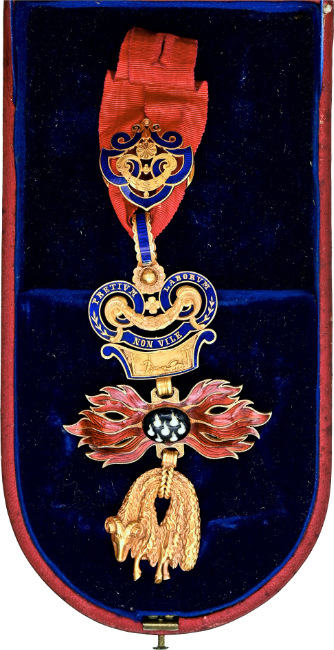
Lot 355: Order of the Golden Fleece. Neck decoration of the knights of the order with eyelet, smaller version. From the estate of Carl Theodor in Bavaria. Estimate: 10,000 euros
The Duke seems to have highly respected his younger brother-in-law. In any case, he solemnly made him the 968th knight of the Order of the Golden Fleece on 4 March 1859. This was a great honor, which was only awarded to two men between 1853 and 1861.
Carl Theodor’s Military Career
At the age of 14, Carl Theodor was old enough to take the military path assigned to him. Exactly as his two brothers did, he chose to join the then most respected branch – the cavalry. On 12 October 1853, he became “Unterlieutenant”, the lowest officer rank, in the 4th Royal Bavarian Chevau-légers. To find out more about the different stages of the military career of young Carl Theodor from Wittelsbach, please refer to Michael Autengruber’s text in the Künker order catalog.
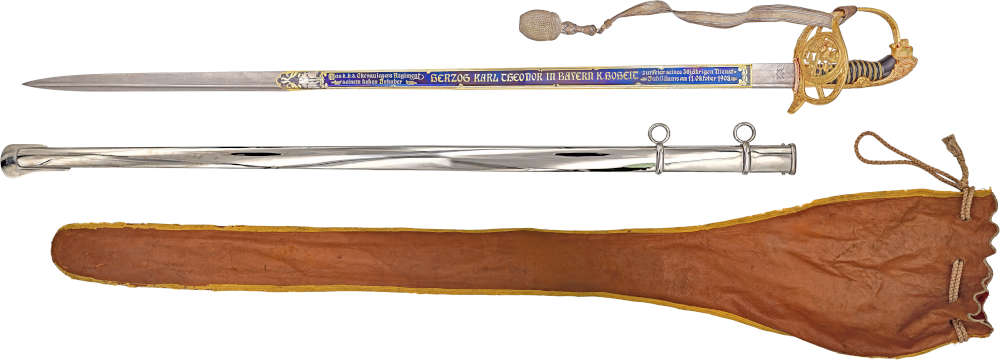
Lot 325: Magnificent Chevau-légers presentation sabre, created and awarded on the occasion of the 50th anniversary of Carl Theodor joining the Bavarian military. Estimate: 10,000 euros.
Proof of this stage in his life is a magnificent Chevau-légers sabre, presented by the 3rd Royal Bavarian Chevau-légers to its owner Duke Carl Theodor in Bavaria on the occasion of his golden anniversary of service on 11 October 1903. This ornate sabre made of Damascus steel was manufactured in Solingen and shows a dedication from the officers of the regiment to their general, as well as a magnificent art-nouveau decoration on its blade. At this point in time, Carl Theodor’s active service had already been over for a long time, of course. He had probably withdrawn from active service in 1867.
A Crisis of Identity
On 11 February 1865, Carl Theodor married the 19-year-old Sophie of Saxony. On 24 December 1865, their first child was born. Only a few months later, Carl Theodor marched with the army as the Austro-Prussian War had begun. Without going into too much detail, we do want to mention that this now almost forgotten war ended in a humiliating defeat for the Habsburg realm and southern Germany. The allies lost 5,658 men in the Battle of Königgrätz. The whereabouts of 7,410 soldiers could never be verified. 22,170 people were imprisoned.
The nightmare was over as early as in late August 1866. The Bavarian troops returned to their quarters in low spirits. Carl Theodor hurried back home to his wife Sophie, who had been fading away since the birth of her daughter. The defeated soldier thus also lost the battle for the life of his wife. She died of influenza, being not even 22 years old on 9 March 1867.
Carl Theodor was hit hard by her death. He left his active military service and began to study in Munich. At first, he was not sure what subject he should concentrate on: the faculty of philosophy with history and all its other aesthetic subjects; or maybe law or political economics? It was only after some time that Carl Theodor’s passion for medicine revealed itself. This decision was probably met with great surprise and even resistance. For example, the Munich professor Theodor von Bischoff was prejudiced against the prince who decided to take up a new occupation. He is believed to have said, “I accept you – not because you are a prince, but despite you are being a prince”.
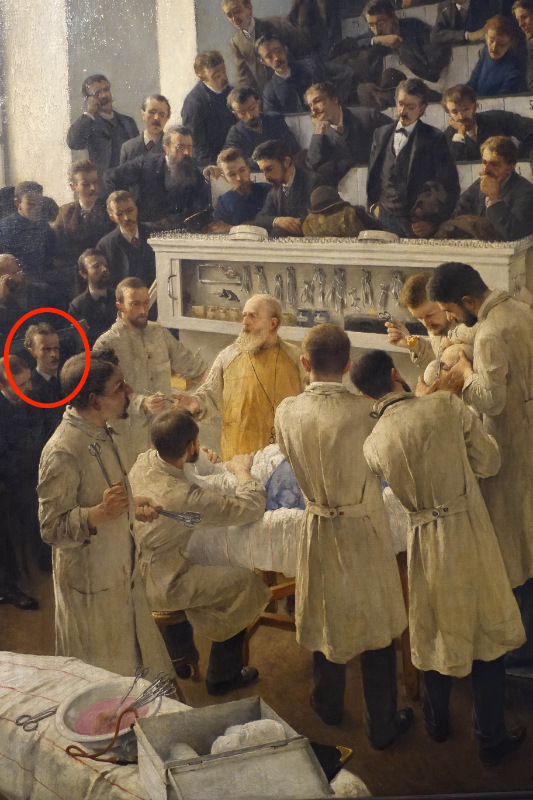
Theodor Billroth operates, painting by Franz Seligmann from 1888-1890. At this time, Carl Theodor had already made himself some reputation as an eye specialist. The artist portrayed Carl Theodor among the students. This may have been a reason for the great success of this painting, which was exhibited in the Glass Palace in Munich in 1890.
A Completely Different Life
Carl Theodor had to march in again as colonel in 1870/1. He took part in the Franco-Prussian War, only to immediately take off his uniform again afterwards and to continue his studies. Since Vienna was the center of modern medicine at that time, Carl Theodor studied some semesters there. He was among the students taught by the famous surgeon Theodor Billroth. Surgery, however, was not the thing that fascinated Carl Theodor. He was rather interested in ophthalmology, the diagnosis and treatment of eye diseases.
Today, we can no longer imagine what it meant for people back then when their eye sight suddenly began to deteriorate. Only the rich were able to afford a pair of glasses or even an expensive operation. Those who lived from hand to mouth, like most of people at the time, had to spend their lives as beggars. And all of a sudden, a small group of doctors discovered how simple it was to help the ones affected. Ferdinand Arlt, for example, who was teaching in Vienna at that time, recognized the cause for short-sightedness and perfected cataract operations. Among his students was Josef Brettauer, who is well-known within the field of numismatics. At that time, he did not only gather the largest coin and medal collection relating to medical topics, but he also introduced local anesthesia for eye surgery using cocaine in 1884. Eduard Jaeger von Jaxtthal, who was also active in Vienna at that time, distinguished between the different forms of cataract and developed test charts, which are still used in eye clinics today. Using this technique, doctors had a consistent measurement to evaluate the deterioration of eye-sight.
Carl Theodor was fascinated. He worked with Ferdinand Arlt in Vienna and then went to Johann Friedrich Horner in Zurich. The latter was not only an eye specialist of worldwide reputation, but had also opened his own private clinic where every other patient was treated free of charge. Carl Theodor probably took a close look at his clinic, as he would soon go on to put similar plans into practice.
New Happiness with a Committed Wife
On 29 April 1874, still during his studies, Carl Theodor married Maria José from Braganza, daughter of the Portuguese king – the man, whom Carl Theodor’s mother Ludovica had loved. Maria José became a congenial partner for Carl Theodor. Even though she had not studied medicine herself, she was nevertheless totally wrapped up in the work of her husband. She did not confine herself to the traditional role of a woman in caring for the poor, but assisted her husband as a surgical nurse during his operations.
In the autumn of 1879, Carl Theodor passed his state exam in medicine at the Ludwig Maximilian University with the highest distinction. Following two extended internships in Vienna and Zurich, he worked free of charge in the district hospital of Tegernsee, which, at that time, was one of many regional hospitals in Bavaria being poorly equipped.
In the spring of 1887, Walter Lund reported on the worthwhile work of Carl Theodor of Wittelsbach in a magazine called Gartenlaube: “The greater part of the year is dedicated to his activities in Tegernsee, whose numerous clients in the district hospital are accommodated at the expense of the princely doctor. With the first breath of spring, however, the Duke, eagerly awaited by hundreds of people, arrives in the garden city at the River Passer. In the period from 20 March to 1 June 1886, Duke Carl Theodor completed 200 surgeries in Merano, including no fewer than 76 cataract extractions. 1160 people having an eye disorder visited his ‘Ambulatorium’ clinic. … However, most of the patients will be all the more grateful to him as they not only received free aid, but also medicine, care and manifold support.”
In the 19th century, the term “Ambulatorium” denoted something similar to Doctors Without Borders today. Carl Theodor brought his equipment, rented rooms for surgery for two and a half months and worked as committed as his modern successors do. Within the ten weeks of his stay, he approximately carried out 116 treatments including 20 surgeries per week. Thanks to him, people who would otherwise have become invalids were able to resume their normal life.
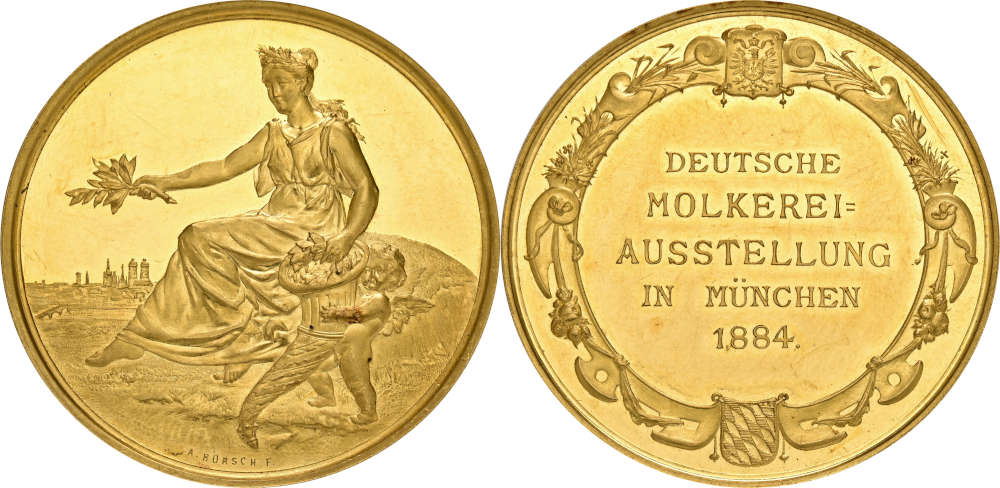
Lot 284: Prize medal of the agricultural association for exhibitors at the German Dairy Exhibition in Munich in 1884. 14-ducat gold medal by Alois Börsch in original case. From the estate of Carl Theodor in Bavaria. Extremely rare. Proof. Estimate: 3,500 euros.
Agricultural Interests
But Carl Theodor did even more. He ran a model farm in Kaltenbrunn, which his mother Ludovica had inherited and which became his property after her death. In 1884, he was awarded a gold medal for his achievements in livestock farming, milk production and cheese production at the large German Dairy Exhibition in Munich.
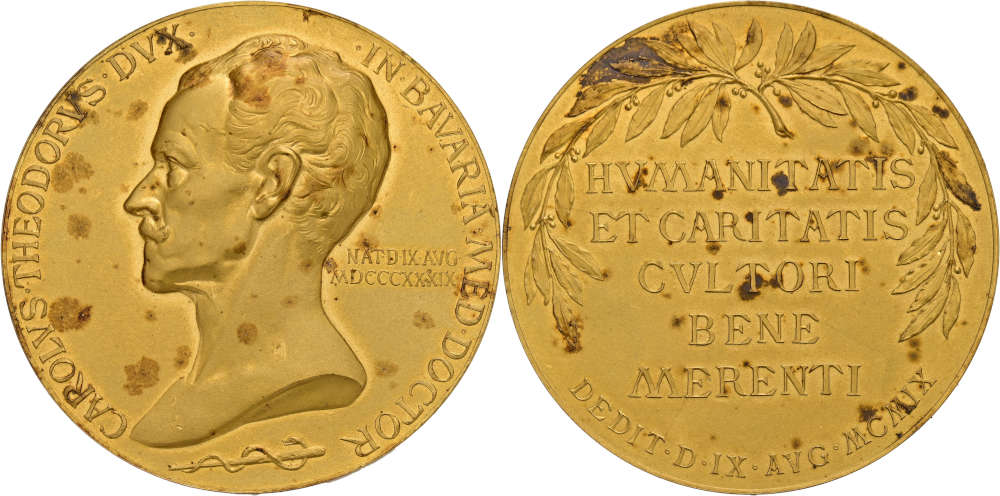
Lot 285: Award gold medal of 14 ducats in original case for medical achievements on the occasion of the 70th birthday of Carl Theodor on 9 August 1909. From the estate of Maria José. Only two gold specimens minted. FDC. Estimate: 5,000 euros.
The Munich Eye Clinic
In 1888, his father Max died and Carl Theodor became head of the house. This also included the right to dispose of the family’s fortune. Carl Theodor thus had the money to build and maintain an eye clinic in Munich. Together with his wife, he acquired a residential building in Nymphenburger Straße 43, where he opened an eye clinic under the name “Wohltätigkeitsanstalt für unbemittelte Augenkranke” (Charity institution for people with an eye disorder and without means).
The facility offered 56 beds and the stay was completely free for patients who did not have money. They received the best care available at that time. Between 1895 and 1909, Carl Theodor saved the eye-sight of more than 5,000 patients through cataract surgery. In addition to her role as a nurse, his wife Marie José took over the organization of the clinic.
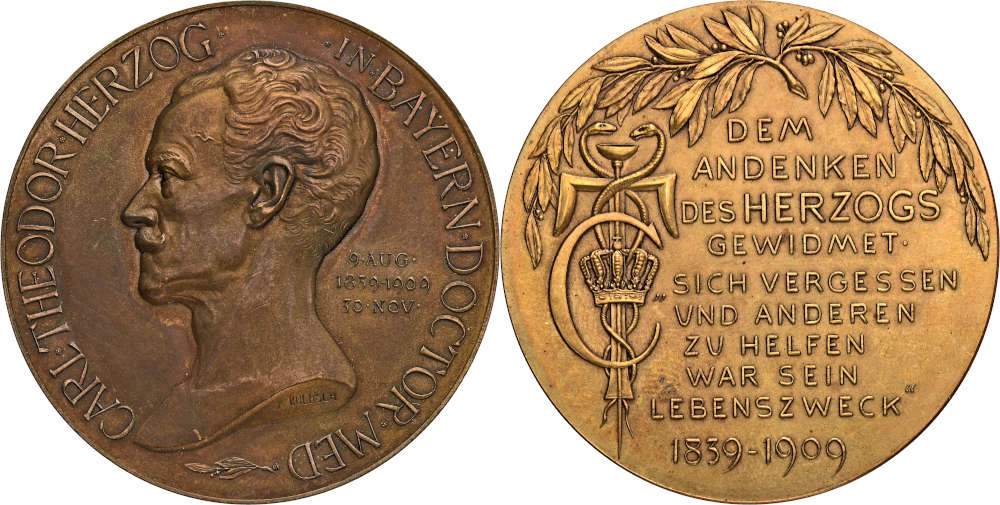
Lot 308: Medal commemorating the death of Carl Theodor on 30 November 1909 in original case. From the estate of Maria José. Extremely rare. Extremely fine. Estimate: 25 euros.
Due to kidney failure, Carl Theodor died on 30 November 1909 in Kreuth. He was buried in the ducal family vault in Tegernsee church. His wife resumed his work. She appointed his assistant, Heinrich Zenker, as medical director of the hospital. She herself did not retire, but continued to run the clinic.
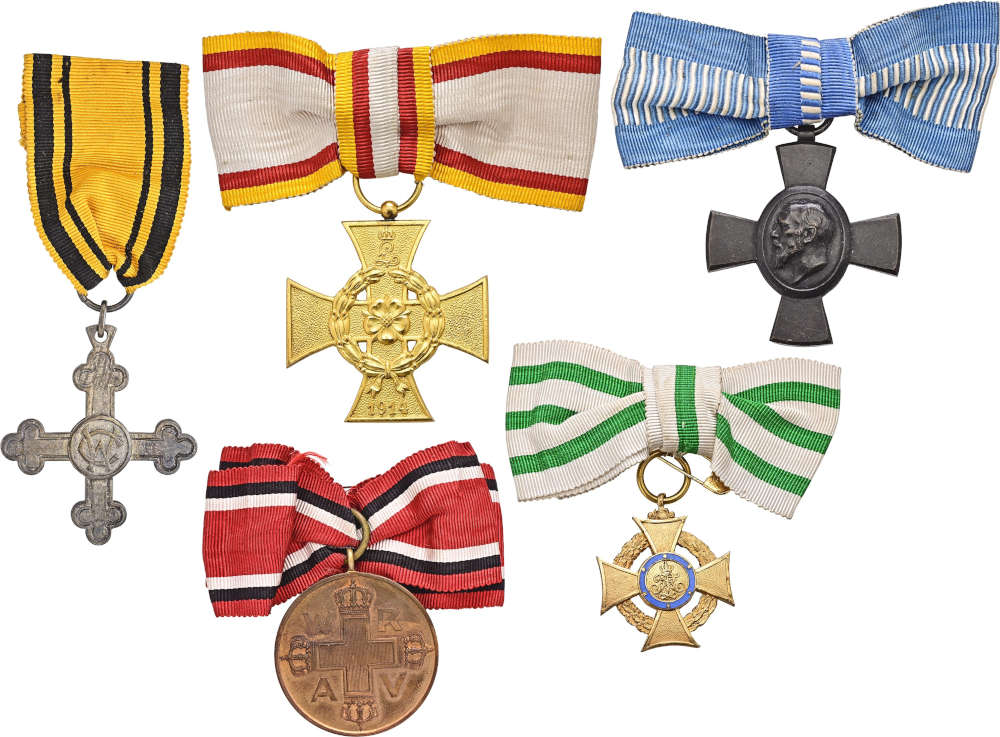
Lot 340: Group of five different ladies’ awards from the First World War. From the estate of Maria José. Estimate: 50 euros.
Marie José: Much More Than the Woman at His Side
Marie José outlived her husband by more than 30 years. And she ensured that his life’s work was being continued.
When the First World War began, she converted the eye clinic into a civilian run military hospital in the summer of 1914. Unlike many of Marie José’s peers, who now also put on a nurse’s uniform, she knew exactly what to do. She acquired an X-ray machine for her clinic, which had previously not been necessary for eye operations. It was used to optimize the treatment of shattered limbs riddled with shrapnel. The Duchess herself seems to have been responsible for operating the X-ray machine and interpreting the images.
In order to guarantee the continued existence of the eye clinic after her death, Marie José established a foundation in 1917. And thus, Carl Theodor’s eye clinic still exists today. It is the legacy of a couple who saw the fact that they were part of the old nobility not as a privilege, but as an obligation. Carl Theodor and Marie José went their own, unconventional path without forgetting to support their poorer fellow human beings.





